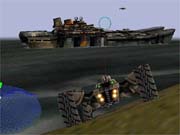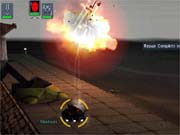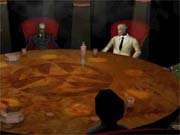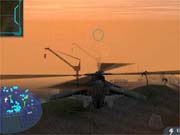Hostile Waters: Antaeus Rising is a breed apart from the typical real-time strategy game. UK development house Rage Software has picked apart the traditional design, which was pioneered by Westwood Studios in such classics as Dune II and Command & Conquer, and developed a captivating fully 3D game that defies convention. Although there is much for the real-time strategy veteran to latch onto in Hostile Waters--including resource gathering, unit construction, enemy base assault, and so on--much has been added, tweaked, or removed altogether from the basic formula. Actually, one of the more significant omissions in Hostile Waters is its lack of multiplayer support. Yet in spite of this, the game's excellent story, action elements, de-emphasis on repetitive base building, and largely automated resource collection ensure that even the most jaded real-time strategy player will find something fresh and exciting in Hostile Waters.

Perhaps the most obvious discrepancy between Hostile Waters and most real-time strategy games is its detailed story. Written by acclaimed comic book author Warren Ellis (Transmetropolitan, The Authority) and told through evocative cutscenes, the tale is emblematic of the best science fiction of John Wyndham (Day of the Triffids, The Kraken Wakes). Unlike the traditional postapocalyptic setting, the scene in Hostile Waters is a "future world gone sane." The year is 2032, and mankind has abandoned weapons and entered into a golden age. Of course, the situation promptly becomes more interesting with the arrival of a cabal of "Old World magnates" bent on regaining their lost power. They promptly establish an artificial island chain in the Pacific and begin launching attacks on the new and improved humanity, apparently with the assistance of aliens. The only hope for this peaceful society is the Adaptive Cruiser Antaeus, a super aircraft carrier and war wagon that's spent the better part of the past two decades rusting at the bottom of the ocean. You must complete 21 missions in the solo campaign to get the vessel back in operating condition and save the world from tyranny.
An inventive plot isn't all that separates Hostile Waters from the pack. The actual gameplay is considerably different from that found in traditional real-time strategy games, such as the recent Emperor: Battle for Dune. For starters, there is no base building. The Antaeus fills that role in every mission, serving as a manufacturing platform where nanotechnology is used to create varied models of helicopters, tanks, dune buggies, hovercraft, and so on. Vehicles can be further tricked out with add-ons such as armor plating, special weaponry, repair modules, cloaking devices, and more. Unit and equipment options are predictably limited at first, but more are discovered or seized from the enemy as the game progresses. Resources must be gathered to power the machines that construct all items, but this has been automated through the use of special armored utility vehicles. These tanklike mechanisms search out scrap metal on the various islands and recycle it into usable energy. Just plop one down in a base you've recently destroyed, and you'll soon be able to fire up the production lines.

Most of the game comes down to assaulting enemy bases for one reason or another and then processing the junk that's left behind into the resources needed to build additional units. This rather familiar formula, which is derivative of countless real-time strategy games, has also been modified in a number of ways. The biggest change is that you can assume direct control over units using a mouse and keyboard setup identical to that of most shooters. As the captain of the Antaeus, you can jump into the cockpit of any vehicle at any time to directly lead an attack or handle a delicate aspect of a particular operation. This lends Hostile Waters a strong action component and makes it play out more like a hybrid action-strategy game, such as Battlezone, than like a conventional RTS game. What's more, this action mode isn't superficial--it's been fully integrated with the more-strategic aspects of the game, so it'll seem completely natural during a battle to hop into an attack chopper (for example) and start firing.
Of course, much of the time you'll be giving tactical orders to your units in the traditional way. Yet even this aspect of the game is markedly different from what you may be accustomed to from real-time strategy. For example, remote units can be piloted by computer chips encoded with the characteristics of soldiers who died in the last war. Their very beings have been preserved courtesy of a controversial government program called Soulcatcher. Each has been captured in his or her entirety, meaning that you get specific personalities and skill sets depending on which soldier you choose. For instance, Ransom is a vicious chopper pilot prone to shouting expletives when shooting down the enemy (though swearing can be turned off if you like your wars curse-free). Patton is a grunt who's at home behind the yoke of a tank. Borden is a cerebral cargo pilot who can't help but wonder how weird it feels to exist as a computer chip. During the course of battle, they'll acknowledge orders in their own irrepressible ways, have spats, cuss out opponents, flirt with one another, and so on. Their personnel records are detailed on mission loading screens, and sometimes even their former military exploits will be shown in cutscenes. By the end of just a few missions, you'll have grown attached to this motley crew and will be looking forward to acquiring the new ones that show up at the end of most expeditions.
Soldiers are usually handed their marching orders from the war room aboard the Antaeus. The game automatically pauses whenever you enter this chamber, making it easy to plan out attacks, group forces, and establish waypoints. Instructions can be given to remote units when you're in direct control of a vehicle by using the pop-up command interface. This is probably the one weak point in the game engine, as it's often too chaotic to fly or drive a unit and simultaneously concoct a strategic attack plan for your comrades. Usually, it's best to drop out to the war room for a momentary breather and a chance to determine the course of events while you're not under fire.

Thankfully, you don't have to worry about micromanagement where Soulcatcher chip-equipped units are concerned. Skilled chopper pilots like Ransom and Korolev are extremely intelligent and possess more than a rudimentary knowledge of battle tactics. Give them direct orders to assault an enemy base behind a hill, and they will use the surrounding terrain as cover. In one mission, Korolev played a game of hide-and-seek with an enemy gun turret she had been ordered to take out. She would creep over a hill, open fire, and then withdraw quickly before the turret could lock on to her heavily damaged Hornet attack copter. It's hard to imagine a human player handling such a situation any differently. Pilots will also juke and dive to avoid enemy fire in dogfights. Some will even veer sideways and strafe their enemies, ensuring that the foe can't simply move horizontally to escape the onslaught.
Hostile Waters is as pretty as it is smart. Production values are extremely high in every aspect of the game. Its proprietary engine is absolutely first-rate, featuring fully 3D island environments that are remarkably true to life. Vehicles are highly detailed and move just like they should, whether they're lumbering tanks or maneuverable choppers. Missile contrails and explosions are so authentic that you'll find yourself flinching away from the monitor on occasion. Map design is handled extremely well. Enemy bases are beehives of activity: Tanks thunder around on patrol, gun turrets swivel to take you into their sights, and even tiny little soldiers and support staff hurry about from office to office. This impression of a living, breathing world is further emphasized by day-and-night cycles that rotate every 10 minutes or so. The sun rises and sets, clouds move in bringing rain and mist, and clearing evening skies can even reveal a vista of stars.
The game's audio is of a similarly high caliber. In-game effects are rendered extremely well, particularly the whirring of helicopter blades and the whump of missile impacts--you can almost feel an enemy missile strike home, particularly if it's a killing blow. The voice acting in Hostile Waters is also exceptional, thanks in large part to the crew of well-known British thespians hired by Rage. Veterans like Tom Baker of Dr. Who fame and Paul Darrow and Glynis Barber of another cult British sci-fi show, Blake's 7, use a subtle reading of their lines to get the script across. Histrionics are kept to a minimum, and even the use of foul language is mostly appropriate. The actors' success at drawing you into the story is testament to how important voice acting is in a game and to why it shouldn't be overlooked.

There is one significant shortcoming in Hostile Waters. Once you finish the solo campaign, you'll also be finished with the game, unless you decide to replay the campaign from scratch. That is, the game includes no multiplayer mode, no skirmish mode, and no map editor. This will no doubt be a serious problem for real-time strategy players accustomed to skirmishing against friends online. The excellent campaign's lengthy series of missions will take the average players at least 30 hours to complete, so the problem isn't that Hostile Waters is too short. Instead, the absence of multiplayer features in Hostile Waters will prevent it from having the same sort of lasting value as some of the most popular real-time strategy games from over the years.
Even though it has no multiplayer features, there can be no denying that Rage has created a very engaging game in Hostile Waters. The company expertly combined new ideas in real-time strategy along with enjoyable action elements--a combination similar to that found in previous critically acclaimed games, such as Uprising and Battlezone. For the most part, these earlier hybrids haven't been commercially successful, and because of its similar characteristics and its lack of multiplayer support, Hostile Waters might not be, either. That's unfortunate, because the innumerable good qualities in Hostile Waters mean that it really shouldn't be missed.